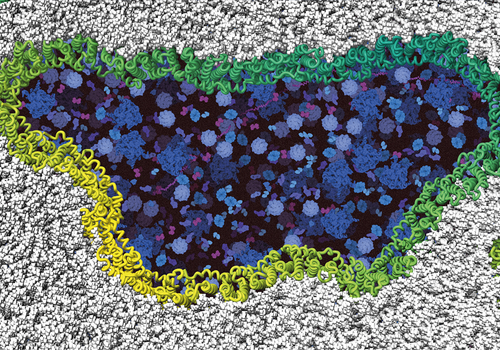Peer-Reviewed Publication UNIVERSITY COLLEGE LONDON IMAGE: ILLUSTRATION OF HUMAN CILIA AXONEME REPEAT The first image of the structures that power human cilia – the tiny, hairlike projections that line our airways – has been produced by a team involving UCL researchers and could lead to much-needed treatments for people with rare cilial diseases. The study,...
Category: <span>biological sciences</span>
Could endometriosis be caused by bacteria? Study offers fresh clues
Heidi Ledford Fusobacterium has been linked with endometriosis. Credit: CNRI/SPL Infection by a particular group of bacteria could be linked to endometriosis, a painful condition that affects up to 10% of women and girls of reproductive age. In a study of 155 women in Japan, members of the bacterial genus Fusobacterium were found in the uteruses of...
Engineered White Blood Cells Eliminate Cancer
Posted on June 12, 2023 Author Melissa Pappas “Macrophages killing cancer cell” photographed by Susan Arnold. By silencing the molecular pathway that prevents macrophages from attacking our own cells, Penn Engineers have manipulated these white blood cells to eliminate solid tumors. Cancer remains one of the leading causes of death in the U.S. at over 600,000 deaths...
Bacteria With a Taste for Inflammatory Compound Could Protect Against Heart Disease
Some bacteria in the guts of humans and mice may help control plaque buildup in arteries, the leading cause of cardiovascular disease, by gobbling up a group of inflammatory chemicals before they can circulate. New research from the University of Wisconsin–Madison and collaborators worldwide identified microbes able to break down uric acid in the low-oxygen environment of the...
How does dopamine regulate both learning and motivation?
NETHERLANDS INSTITUTE FOR NEUROSCIENCE – KNAW IMAGE: PAVLOVIAN VERSUS OPERANT CONDITIONING EXPERIMENT CREDIT: NETHERLANDS INSTITUTE FOR NEUROSCIENCE A new study from the Netherlands Institute for Neuroscience brings together two schools of thought on the function of the neurotransmitter dopamine: one saying that dopamine provides a learning signal, the other saying that dopamine drives motivation. ‘But...
Lung infection caused by a little-known bacterium may be less transmissible than thought
by Illima Loomis, Harvard Medical School Credit: Pixabay/CC0 Public Domain A little-known bacterium—a distant cousin of the microbes that cause tuberculosis and leprosy—is emerging as a public health threat capable of causing severe lung infections among vulnerable populations, those with compromised immunity or reduced lung function. Previous research had found that various strains of the bacterium Mycobacterium abscessus...
Under control to the very end – how our cells kill themselves
UNIVERSITY OF BASEL IMAGE: NINJURIN-1 PROTEINS ASSEMBLE (GREEN/YELLOW) INTO FILAMENTS AND RUPTURE THE CELL MEMBRANE (GRAY) UNTIL THE CELL DISINTEGRATES COMPLETELY. INTRACELLULAR COMPONENTS ARE SHOWN IN BLUE. CREDIT: BIOZENTRUM, UNIVERSITY OF BASEL Every day, millions of cells die in our body. Other than generally assumed, cells do not simply burst at the end of their...
New production process for therapeutic nanovesicles
by University of Basel The extracellular vesicles (red) produced using the new technique are absorbed in vitro by immune cells (green; nucleus in turquoise) and can therefore influence an organism’s immune response. Credit: C. Alter, Department of Pharmaceutical Sciences, University of Basel Particles known as extracellular vesicles play a vital role in communication between cells and...
Are telomeres really the key to living longer, youthful lives?
Telomeres — the “caps” on the end of chromosomes that protect the DNA from damage — have been associated with greater longevity. In theory, longer telomeres should allow a cell to divide more times and therefore live longer. However, a new study has suggested that longer telomeres could increase a person’s risk of chronic health...
Researchers reveal DNA repair mechanism
by NYU Langone Health The study enzyme RNAseHII repairs DNA by riding along on the enzyme that reads the genetic code, RNA polymerase, and cutting out (see scissors) misplaced code letters when it “sees” them in bacterial genetic material. Credit: Cell Press A new study adds to an emerging, radically new picture of how bacterial cells...








